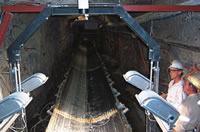 A recent newsletter published by WipWare Inc., a North Bay company specializing in photoanalysis systems for particle sizing, welcomes new customers from India, the Ukraine, Korea, Japan, Peru the U.S. and the United Kingdom.
A recent newsletter published by WipWare Inc., a North Bay company specializing in photoanalysis systems for particle sizing, welcomes new customers from India, the Ukraine, Korea, Japan, Peru the U.S. and the United Kingdom.
Some sales to Canadian mining companies are also acknowledged, but the list clearly reflects WipWare’s decided emphasis on the export market.
“Canadians were coming back from international conferences in Johannesburg and Santiago and phoning us to ask about Wipfrag,” said company president Tom Palangio.
Founded in 1995 by Palangio and two professors from Waterloo University who developed the software, WipWare has recently undergone a change in ownership and embarked on a new strategy to serve the domestic market. In April, Palangio bought out the last of his two partners and, launched a new company, the Bonfield Group, to market the company’s photoanalysis systems and complementary products in Canada.
WipWare has a network of 40 distributors around the world, but until now, none covering the domestic market.
The Bonfield Group also sells a moisture measurement system and a line of active RFID tags that WipWare uses to identify load-haul-dump machines or haul trucks and, therefore, the source of the ore measured by its photoanalysis systems.
A veteran of the explosives industry, Palangio began the search for a particle sizing solution while working for Dupont in the ’80s.
The old-fashioned way of passing a sample of blasted ore through a sieve was time-consuming and imprecise. The search took him to Waterloo University in southern Ontario, where Dr. John Franklin and Dr. Norbert Maerz took up the challenge and began working on a solution. At first, students were enlisted to trace every rock fragment in a photograph, but as work progressed, software was developed to automate the process
“In 1995, when Dupont was sold to Explosives Technologies International, I decided to start my own consulting business, so I approached Franklin and Maerz about commercializing the software,” recalled Palangio.
By that time, the solution was well known in the industry and in great demand.
“It was easy,” said Palangio. “I sold the system all over the world. I got swept up with doing all this international work and forgot completely about the domestic market.”
Digital imaging
Improvements in digital imaging technology and continued R&D over the years have taken Wipfrag to a whole new level.
“It used to take us an hour to analyze an image. Now, we can grab an image off a conveyor belt and do all the sizing in an eighth of a second, so we can give you real-time monitoring.”
WipWare can set up its cameras and computers with photoanalysis software over conveyor belts, mounted to the back of haulage ways underground, or on surface, where haul trucks dumps ore into a primary crusher. In the latter two examples, RFID tags on the vehicles activate the system and identify the source of the ore.
Particle size analysis allows miners to fine-tune drilling and blasting for optimum fragmentation.
“By taking a pattern and expanding it out, you can save some drill holes, bits and explosives, but you may not be saving the company any money because the maintenance costs for the vehicles have gone up,” said Palangio.
“They’re breaking the teeth on the buckets because the material is too coarse. They’re wearing out the tires because they’re having a hard time scooping up the muck. They’re springing leaks in the hydraulics hoses and they’re busting cylinders. The guy up front may be saving $200,000, but maintenance all of a sudden went up one million dollars.”
There is also an impact further downstream, Palangio continued.
“If you don’t break (the ore) properly with explosives because you expanded the pattern, the crusher has to do the job and, in Ontario, we’re paying a tremendous amount for electrical energy. With the data we provide, you can see for a certain fragmentation size what your total cost of production is and you can gauge yourself. It’s very difficult to do in the absence of the data we can provide. There’s no other practical way of doing it.”
On the other hand, if the particles resulting from a blast are too small, “you get dust and it just gets trampled down into the ground.”
There is an optimum particle size for every operation, said Palangio.
“Just because they’re doing it one way in Onaping doesn’t mean it will work somewhere else. It doesn’t work like that because the geology is different. The loaders and the crushers may be different, too, so it’s the biggest jigsaw puzzle in the world. There are so many variables.”
Fragmentation can be fine-tuned by changing the drill patterns, the size of the holes, the explosives and the timing of the initiation sequence.
“Whether you’re drilling, blasting, crushing or grinding, you have to track the material sizes so you know how well you’re doing,” noted Palangio.
“SAG mills are such an inefficient way of breaking material, it’s pathetic. The engineers tell us that 95 per cent of the electrical energy that goes into a SAG mill gets turned into heat and noise, so less than five per cent goes into breakage. If you don’t put the proper size material into a SAG mill, you’re really working against yourself.”
Aside from applications in the mining industry, WipWare’s particle sizing solutions can be used in agriculture, food processing and wood products industries. Coal generating stations are also using the company’s photoanalysis solutions to measure coal particle sizing for optimal combustion.


